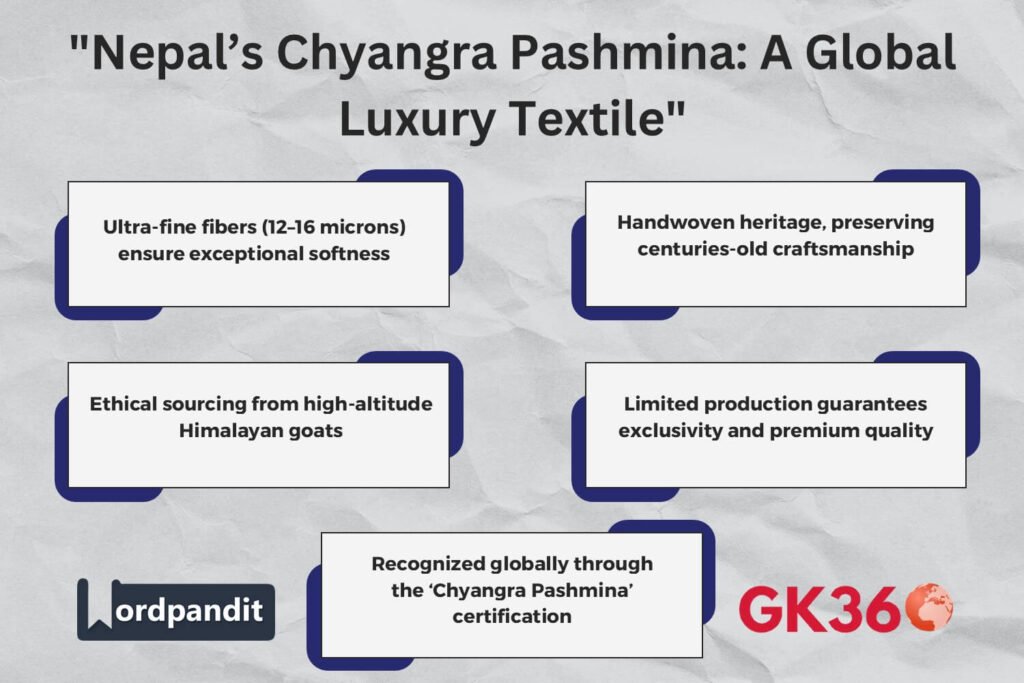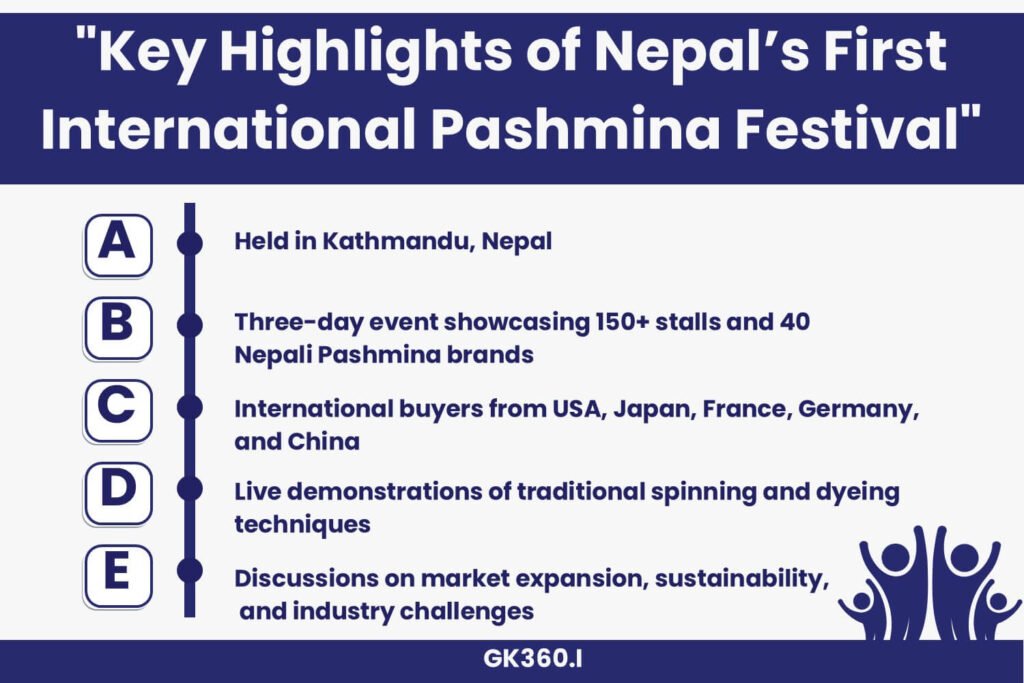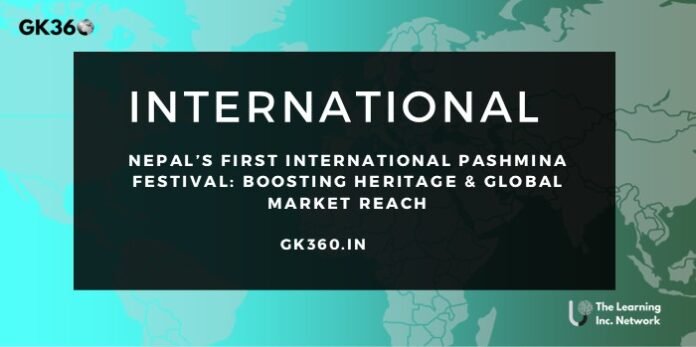Nepal’s First International Pashmina Festival: Boosting Heritage & Global Market Reach
Nepal recently hosted the first-ever International Pashmina Festival, a landmark event that showcased the nation’s rich textile heritage and global aspirations for the luxury Pashmina industry. Organized by the Nepal Pashmina Industries Association (NPIA) and the Confederation of Nepalese Industries (CNI), the festival attracted artisans, buyers, industry experts, and policymakers, creating new opportunities for Nepal’s Chyangra Pashmina in international markets.
Renowned for its softness, warmth, and lightweight texture, Nepalese Pashmina is sourced from the undercoat of the Chyangra (Pashmina) goat, found in the Himalayan region. This festival served as a crucial platform to celebrate Nepal’s craftsmanship, highlight sustainable practices, and address challenges in the $1.5 billion global Pashmina market.

Table of Contents
- The Essence of Nepal’s Chyangra Pashmina
- Highlights of the International Pashmina Festival
- Market Trends and Global Demand
- Challenges in Nepal’s Pashmina Industry
- Sustainability and Ethical Practices
- Government & Industry Collaboration
- The Future of Nepalese Pashmina
- FAQs
- Conclusion
The Essence of Nepal’s Chyangra Pashmina
Nepalese Chyangra Pashmina is a globally recognized luxury textile known for its:
- ✅ Soft, ultra-fine fibers (diameter of 12–16 microns)
- ✅ Handwoven heritage passed down through generations
- ✅ Limited production, ensuring exclusivity
- ✅ Sustainability—sourced ethically from Himalayan goats
Unlike mass-produced wool blends, authentic Nepali Pashmina undergoes a meticulous process, from hand-combing raw fibers during the natural shedding season to traditional spinning, dyeing, and weaving on wooden looms.
Highlights of the International Pashmina Festival
- Location: Kathmandu, Nepal
- Duration: Three days
- Participants: 150+ stalls, including 40 exclusive Nepali Pashmina brands
- Global Reach: Buyers from USA, Japan, France, Germany, and China
The festival celebrated Nepal’s weaving heritage and provided a B2B platform for international trade. Artisans demonstrated traditional spinning and dyeing techniques, while discussions focused on supply chain improvements and market expansion.
Market Trends and Global Demand
Nepal’s Pashmina industry is a major contributor to the country’s exports.
- Current Export Value: Estimated at $35 million annually
- Growth Potential: The luxury Pashmina market is projected to reach $2.4 billion by 2030
Top Importing Countries:
- 🇺🇸 United States & Canada – High demand for luxury scarves and shawls
- 🇯🇵 Japan & South Korea – Favor premium handwoven textiles
- 🇫🇷🇩🇪 Europe (France, Germany, UK) – Ethical fashion & sustainability trends drive demand
Nepal’s Chyangra Pashmina Certification Trademark helps authenticate genuine products and boost global recognition.
Challenges in Nepal’s Pashmina Industry
Despite its rich legacy, Nepal’s Pashmina industry faces several obstacles:
🔴 1. Raw Material Shortages
- Chyangra goats are limited to high-altitude regions, restricting fiber supply.
- Climate change is affecting grazing lands and wool quality.
🔴 2. Counterfeit & Synthetic Pashmina
- The global market is flooded with fake Pashmina (often mixed with synthetic fibers).
- Fake products, sold at 50–70% lower prices, affect Nepal’s artisans.
🔴 3. High Production Costs
- Handwoven, ethical Pashmina requires intensive labor, increasing prices.
- Competing with machine-made alternatives from China & India is challenging.
🔴 4. Limited International Marketing
- Lack of branding, digital marketing, and e-commerce platforms for Nepalese artisans.
To counter these challenges, industry leaders at the festival proposed stricter quality control, global branding efforts, and government support.
Sustainability and Ethical Practices
Nepal’s handwoven Pashmina aligns with growing sustainability trends:
- ✅ Ethically sourced fibers – No harm to Chyangra goats
- ✅ Natural dyes – Reducing chemical waste in production
- ✅ Handmade craftsmanship – Supporting local communities & fair trade
Fashion brands and designers worldwide are shifting toward eco-friendly luxury textiles, making Nepali Pashmina a highly desirable product for conscious consumers.
Government & Industry Collaboration
At the festival, key industry figures emphasized policy-level support to grow Nepal’s Pashmina sector.
Key Announcements:
- 📢 Minister for Industry, Commerce & Supplies, Damodar Bhandari pledged funding for Pashmina R&D and raw material supply expansion.
- 📢 Chandra Dhakal, President of FNCCI called for public-private partnerships to improve marketing and branding.
- 📢 The government plans to increase trade agreements with European & Asian markets to expand exports.
The Future of Nepalese Pashmina
🔮 Future Growth Opportunities:
- ✔️ E-commerce Expansion – Creating global online platforms for Nepalese brands
- ✔️ Innovative Designs – Merging traditional weaving with modern fashion trends
- ✔️ Advanced Certification Systems – Strengthening intellectual property rights against counterfeits
- ✔️ Sustainable Growth Initiatives – Promoting eco-friendly production to attract premium buyers
With strategic government support and global partnerships, Nepal’s Pashmina industry is poised for exponential growth.

FAQs
1️⃣ What makes Nepali Pashmina different from other wool fabrics?
Nepali Pashmina is made from the ultra-soft undercoat of Chyangra goats, making it finer, warmer, and more luxurious than regular wool.
2️⃣ How can buyers identify authentic Nepalese Pashmina?
Look for the ‘Chyangra Pashmina’ certification and ensure the product is handwoven with natural fibers.
3️⃣ Why is Nepal struggling with counterfeit Pashmina products?
Mass-produced synthetic blends, mainly from China and India, are misleading consumers and harming Nepalese artisans.
4️⃣ How does Nepal’s government support the Pashmina industry?
Through funding for research, global marketing efforts, and policies to protect Nepalese artisans.
5️⃣ What are the key export markets for Nepalese Pashmina?
The USA, Japan, France, Germany, and South Korea are major importers of authentic Nepali Pashmina.
Conclusion
The first-ever International Pashmina Festival marked a significant milestone for Nepal’s luxury textile industry. By celebrating traditional craftsmanship, tackling industry challenges, and expanding global markets, Nepal’s Pashmina sector is set to thrive.
For Nepal to remain a global leader in premium Pashmina, sustained government backing, innovative marketing, and strict quality control are crucial. With rising demand for sustainable, ethically made textiles, the future of Nepali Pashmina looks incredibly bright.
Key Takeaways Table
| Aspect | Details |
|---|---|
| Chyangra Pashmina Heritage | Handwoven, ultra-fine, ethically sourced luxury fabric. |
| Festival Location & Scale | Held in Kathmandu with 150+ stalls and global participants. |
| Market Growth | Nepal’s Pashmina exports valued at $35M annually, with a $2.4B market potential by 2030. |
| Industry Challenges | Counterfeit products, raw material shortages, and high production costs. |
| Sustainability Focus | Ethical sourcing, natural dyes, and handmade production align with eco-conscious trends. |
| Government & Industry Support | Nepal’s government pledged funding and trade agreements for global expansion. |
| Future Opportunities | Digital marketing, e-commerce, and stronger certification systems to boost international sales. |
Related terms
- Nepal Pashmina Festival 2024
- Chyangra Pashmina Certification
- Luxury Pashmina Market
- Ethical Fashion Trends
- Nepal Handwoven Textiles
- Sustainable Cashmere Industry
- Pashmina Export Growth
- Counterfeit Pashmina Issues
- Handmade Pashmina Scarves
- Nepalese Textile Heritage





